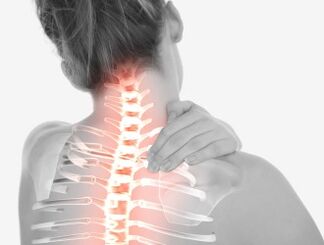
Spinal diseases are unpleasant in themselves, but they present the greatest risk if they affect the cervical region.
Even such a harmless pathology in appearance asOsteochondrosis of the cervical region, can provoke the appearance of headaches, difficulty circulating blood, damaged work of internal organs.
In the absence of treatment, osteochondrosis can lead to the development of other, more serious diseases.
To avoid this result, you should carefully monitor your health and see a doctor when the first symptoms of osteochondrosis appear.
Fortunately, modern medicine has methods that allow this disease to treat this disease quickly and effectively.
What is it
Cervical osteochondrosis is a pathology in whichThe soft intervertebral pulp turns into an ossed fabric.Moreover, blood vessels and nerve roots are involved in pathogenesis.Osteochondrosis of the cervical region has the ability to mask itself for various disorders.
Clinical
A distinctive feature of cervical osteochondrosis is pain in the neck, head, upper spine.Patients can complain of dizziness, lack of air, dance in blood pressure, nausea, language numbness, loss of consciousness.Often they suspect angina pectoris and other diseases of the cardiovascular system.
ClaSSIFICaTION
Classification of cervical osteochondrosis may be in relation to the degree of development of the disease:
- 1 degree - degenerative -district changes in the intervertebral discs occur;
- 2 degrees - the vertebrae themselves undergo changes;
- 3 degrees - intervertebral hernia.
Dominance and meaning
Cervical back osteochondrosis "becomes younger" literally before our eyes.An examination of patients of different ages who have a tendency for osteochondrosis showed that in the current problems of young people with the spine arise much earlier (sometimes the first symptoms of the disease appear in adolescence) than representatives of the older family generation.
People who were born 60-70 years ago contact clinics about osteochondrosis in mature and old old age, although people who were born 20-40 years ago get sick of osteochondrosis even at a young age.This trend is evidence of a significant deterioration in the health of the new generation caused by a decrease in food quality and a sedentary lifestyle.
Clinical manifestations of osteochondrosis are found in about 60 percent of adults living in European countries.It is noted that women receive cervical osteochondrosis at the age of 50-55, and men aged 45-50.
Risk factors
The chances of obtaining osteochondrosis increases if available:
- spine development abnormalities;
- excess weight;
- long physical exercise;
- bad habits (smoking);
- sedentary lifestyle;
- work, which implies the regular impact of vibration on the back (for example, with drivers);
- long stress, excess nerve tension;
- local hypothermia;
- preliminary damage to the neck and nape;
- Autoimmune pathologies that bring about cartilage degeneration.
Reason
The main reasons for the development of osteochondrosis include:
- genetic predisposition;
- Disturbed metabolic process;
- Poor physical development.
It is difficult to determine the exact cause of the appearance and development of cervical osteochondrosis because this disease occurs in young and elderly people involved in sports and lead a sedentary lifestyle.
Psychosomatic
The development of cervical osteochondrosis indicates the inability to withstand competence problems.Sometimes people become so strong and confident in their abilities that their stability before the calamity turns into stiffness and lack of flexibility.In this case, efforts to turn their head are associated with stiffness, convulsions and other unpleasant sensations.
Also, osteochondrosis can develop in people who are afraid of problems and do not know how to cope with them.In this case, the protective reflex of the mammals is caused, and the head is literally drawn to the shoulders.This provision is considered unnatural, therefore, after some time, the muscles of the cervical region begin to damage and deform.
Consequences
Reduce muscle elasticity and flexibility in the joints- Signs of natural aging of the body.However, in patients with osteochondrosis, they appear much earlier than in healthy people.Osteochondrosis can cause the development of migraines, hypertension, respiratory diseases, spinal and brain ischemia, stroke, etc.
Improper treatment of osteochondrosis is no less dangerousas a lack of treatment.A physician's inappropriate actions can lead to a constant genuine deterioration or unexpected disability.
Symptoms and diagnostic methods
The main signs of osteochondrosis of the cervical region include:
- pain in the back of the head, neck, arm and shoulder, which intensify when sneezing, coughing and minimal load on the arm;
- burning between shoulder blades, tingling in the legs or wings, numbness;
- pain and cramping in the neck that occur during the slope and curves of the head;
- fatigue, weakness;
- Fainting and dizziness derived from sharp head curves;
- Headaches, which usually begin at the back of the head, spread to temples and crowns.
Other signs of cervical osteochondrosis include ear noise, hearing damage, and a decrease in visual acuity.Sometimes the disease makes itself feel by attracting pain in the heart area.
At the first signs of cervical osteochondrosis, you should consult a doctor who will perform a comprehensive examination, will diagnose.In this case, such diagnostic methods as MRI, laboratory studies, ultrasound, ECG may be used.
Treatment
The treatment of cervical osteochondrosis depends on the stage of the disease.If in the first phase there is a very conservative, woven treatment, then in the second and third stages the doctor's task is, first of all, to stop the pain syndrome.Enlarged cases may require surgical treatment intended for decompression and stabilization of vertebrae.
drug
People with osteochondrosis of the cervical region may be described:
| assort | Description |
| NSAIDs (non -steroidal anti -inflammatory drugs) | Help to remove swelling and pain. |
| Vasodilat | Contribute to improving blood circulation. |
| Soothing, relaxing muscle | They are also described to ease the patient's overall condition and reduce NSAID doses.Stretch at the same time nerve overload and muscle cramps, help to achieve a better therapeutic effect. |
At the end of the flow of therapy, NSAID should be purchased for a first bag of the house, because the pain in the neck can be periodically returned (with stress, overload, weather change).Before taking any drugs, consult your doctor.
Surgical treatment
If a positive effect is not observed after a conservative treatment of a conservative treatment, the doctor may recommend the spinal fussia.This procedure allows you to immobilize the affected vertebral segment.Its essence is to remove the intervertebral disc, decompression of the nerve root, implant installation or the creation of the physiological height of the disk space.
Operation has many side effects and contraindications.So it can cause vertebrogen disability.That is why surgery is performed in extreme cases.
Exercises, exercise therapy, massage
Massage with cervical osteochondrosis allows you to achieve significant improvements.It is important for the procedure to be performed by a professional: the disabled movements in the cervical backpack can aggravate the situation.Movements should affect the Jaka area, cervical region and part of the back.

Massage for osteochondrosis means alternating the following actions.
- Stroke.Massage affects the surface layers of the skin, moving from the head to the upper third of the middle of the back.At the same time, palms or fingertips work.
- reamer.Deep skin layers located in the upper third of the back are exposed.In this case, the index and thumb of the hands through the neck are performed to get the skin.The fabrics adjacent to the beads are not included in this process.
- Trumpet.It is performed to heat the skin, to increase the blood flow to the collar area.The procedure should be performed extremely carefully.It is forbidden to affect spinose bead processes.Sometimes friction is replaced by circular strokes or movements that resemble the saw.
- Food.It affects deep -stretched fabrics, so it has a limited value.Can worsen the pathology.
During massage, the patient should extend to his stomach, in extreme cases, to decrease.
Also useful for cervical osteochondrosis may be LFK.Regular classes contribute to strengthening muscle lane, reducing the load on the cervical spine.You can practice exercise therapy at any stage of pathology as well as for prevention.During the irritation, the complex is performed with special care.
Standard exercises for the treatment of cervical osteochondrosis are:
- the curves of the head from side to side;
- Tilts of the head back and forward;
- Shoulder lifting with hands fixed or relaxed by holding them in this position of 15 to 20 seconds;
- Following the extensors and neck flexors, when the head is in a fixed position.
Eachdo Exercise is repeated five to seven times.Lesson continues for 15-20 minutes.The exercise group should be selected by the LFK specialist, taking into account the stage of the disease and the condition of the patient.
Home treatment
The treatment of osteochondrosis at home is rarely practiced, for example, in the first stage of the disease.
In this case, the patient is recommended:
- adjust the behavior;
- Equip a job correctly;
- Do simple physical exercises, including in the workplace.
A positive impact on the skeletal muscle system will have the use of vitamins and minerals, an increase in motor activity as well as swimming.
PREVENTION

For the prevention of the disease, recommended:
- Sleep on an orthopedic pillow and mattress;
- Take a hot shower daily for 10 minutes;
- Visit a bath or sauna (relieves neck muscle cramps);
- Avoid sharp tiles and head curves;
- Walk more on foot, make yoga and swimming;
- With "sitting" work, take five -minute vacation every hour (you have to walk during the holidays, tilts with a body and head in different directions);
- Avoid increasing the load on your back: classes with weights, jumps, jogging;
- Choose chairs and chairs that support the spine;
- abandon addictions, such as smoking, alcohol abuse;
- Drink at least one and a half liters of water a day.
Nutrition with cervical osteochondrosis is often recommended (at least five times a day) and in small portions.Preference should be given to steamed or cooked dishes.Salads should be seasoned with olive oil.
Recovery prediction
Forecasting for qualified and timely treatment is favorableHowever, much depends on the patient's age, the severity of the manifestations and the stage of the disease.It is also important in which the person performs medical recommendations regarding food, lifestyle and elimination of bad habits.
cONcluSiON
Thus, in most casesOsteochondrosis of the cervical regionIt is possible to cure.However, it is worth remembering that the disease can be returned at any time.To prevent this, it is necessary to observe prevention measures and a healthy lifestyle.
In addition, it's worth remembering:
- The cause of osteochondrosis is difficult to settle.
- The symptom of the disease is pain in the back of the head and neck.
- Cervical osteochondrosis is treated comprehensively: medicines (mainly NSAIDs), massages, exercise therapy.























